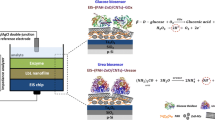Abstract
Biodevices in which biomolecules such as enzymes and antibodies are immobilized on the surface of electrode materials are capable of converting chemical energy into electrical energy, and are expected to contribute to solving energy problems and developing medical measurements especially as biobatteries and biosensors. Device performance depends on the interface formed between the biomolecule layer and electrode material, and the interface is required to simultaneously achieve a highly efficient enzymatic reaction and electron transfer. However, when enzymes were immobilized on a material surface, the enzymes undergoes a structural change due to the interaction between the enzyme and the electrode surface, making it difficult to maximize the function of the enzyme molecule on the material surface. In this study, we postulate that the structural change of the enzyme would be reduced and the electrochemical performance improved by making the contact area between the enzyme and the electrode extremely small and adsorbing it as a point. Therefore, we aimed to develop a high-power biodevice that retains enzyme structure and activity by interposing gold nanoparticles (AuNPs) between the enzyme and the electrode. The enzymatic and electrochemical properties of pyrroloquinoline quinone-dependent glucose dehydrogenase adsorbed on AuNPs of 5–40 nm diameter were investigated. We found that the characteristics differed among the particles, and the enzyme adsorbed on 20 nm AuNPs showed the best electrochemical characteristics.


Similar content being viewed by others
References
Barton SC, Gallaway J, Atanassov P (2004) Enzymatic biofuel cells for implantable and microscale devices. Chem Rev 104:4867–4886
Davis F, Higson SPJ (2006) Biofuel cells-recent advances and applications. Biosens Bioelectron 22:1224–1235
Durand F, Claire S-C, Flexer V, André I, Mano N (2010) Designing a highly active soluble PQQ-glucose dehydrogenase for efficient glucose biosensors and biofuel cells. Biochem Biophys Res Commun 402:750–754
Himmel ME, Ding SY, Johnson DK, Sadney W, Nimols MR, Brady JW, Foust TD (2007) Biomass recalcitrance: engineering plants and enzymes for biofuels production. Science 315:804–807
Holland T, Lau C, Brozik S, Atanassov P, Banta S (2011) Engineering of glucose oxidase for direct electron transfer via site-specific gold nanoparticle conjugation. JACS 133:19262–19265
Holzinger M, Goff AL, Cosnier S (2012) Carbon nanotube/enzyme biofuel cells. Electrochim Acta 82:179–190
Karra S, Zhang M, Gorski W (2013) Electrochemistry and current control in surface films based on silica-azure redox nanoparticles, carbon nanotubes, enzymes, and polyelectrolytes. Anal Chem 83:1208–1214
Kim L, Jia HF, Wang P (2006) Challenges in biocatalysis for enzyme-based biofuel cells. Biotechnol Adv 24:296–308
Rabaety K, Verstraete W (2005) Microbial fuel cells: novel biotechnology for energy generation. Trends Biotechnol 23:291–298
Rabaey K, Boon N, Siciliano SD, Verhaege M, Verstraete W (2004) Biofuel cells select for microbial consortia that self-mediate electron transfer. Appl Microbiol Biotechnol 70:5373–5382
Rengaraj S, Kavanagh P, Leech D (2011) A comparison of redox polymer and enzyme co-immobilization on carbon electrodes to provide membrane-less glucose/O2 enzymatic fuel cells with improved power output and stability. Biosens Bioelectron 30:294–299
Roach P, Farrar D, Perry C (2006) Surface tailoring for controlled protein adsorption: effect oftopography at the nanometer scale and chemistry. JACS 128:3939–3945
Rubenwolf S, Strohmeier O, Kloke A, Kerznmacher S, Zengerle R, Stertten FV (2010) Carbon electrodes for direct electron transfer type laccase cathodes investigated by current density–cathode potential behavior. Biosens Bioelectron 26:841–845
Sakamoto H, Komatsu T, Yamasaki K, Satomura T, Suye S (2016) Design of a multi-enzyme reaction on an electrode surface for l-glutamate biofuel anode. Biotechnol Lett 39:235–240
Tanne C, Gobel G, Lisdat F (2010) Development of a (PQQ)-GDH-anode based on MWCNT-modified gold and its application in a glucose/O2-biofuel cell. Biosens Bioelectron 26:530–535
Yehezkeli O, Tel-Vered R, Raichlin S, Willner I (2011) Nano-engineered flavin-dependent glucose dehydrogenase/gold nanoparticle-modified electrodes for glucose sensing and biofuel cell applications. ACS Nano 5:2385–2391
Yi X, Huang-Xian J, Hong-Yuan C (2000) Direct electrochemistry of horseradish peroxidase immobilized on a colloid/cysteamine-modified gold electrode. Anal Biochem 278:22–28
Author information
Authors and Affiliations
Corresponding author
Additional information
Publisher's Note
Springer Nature remains neutral with regard to jurisdictional claims in published maps and institutional affiliations.
Rights and permissions
About this article
Cite this article
Mori, S., Kitta, Y., Sakamoto, H. et al. Electrochemical characteristics of a gold nanoparticle-modified controlled enzyme–electrode contact junction electrode. Biotechnol Lett 43, 1037–1042 (2021). https://doi.org/10.1007/s10529-021-03092-3
Received:
Accepted:
Published:
Issue Date:
DOI: https://doi.org/10.1007/s10529-021-03092-3




